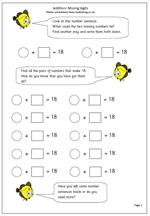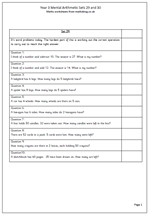 We are well under way with our sets of Year 3 Mental Arithmetic worksheets, with sets 39 and 40 coming up this week. Remember these pages can be used in a number of different ways. The questions can be read out and answered orally, or the answers can be written down on paper. The question sheets can be printed out and used whilst reading the questions out loud as an extra help.
We are well under way with our sets of Year 3 Mental Arithmetic worksheets, with sets 39 and 40 coming up this week. Remember these pages can be used in a number of different ways. The questions can be read out and answered orally, or the answers can be written down on paper. The question sheets can be printed out and used whilst reading the questions out loud as an extra help.
This week the questions are all on addition and subtraction and children who are good at maths will use a variety of different approaches to answer them.
For example: ‘How many are 12, 12 and 13?
One approach is to add 12 and 12 and then add 13 to the answer.
Another approach is to double 12 and add 13 to the answer.
A third approach is to multiply 12 by 3 and add 1. This is probably the quickest method if children know ‘times tables’ up to 12 x 12.
Whichever approach is used, one of the most valuable aspects of giving mental arithmetic questions is to follow it up by asking what approach was used, and suggesting methods which might be more efficient.








